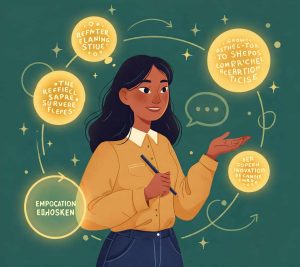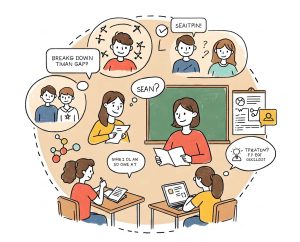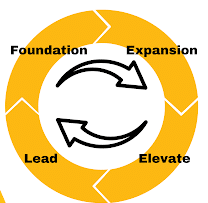Guest post by Laura Szmuch
Learning a new language is not only a cognitive activity but a multilevel process. It involves adjustments in the learners’ behavior and the way they interact with their environments. It brings about changes in the capabilities and strategies which guide their new behaviors, and of course, it can also generate a transformation on their beliefs or belief systems, and cause an expansion of their matrix of identity. It can even modify their relationship with something bigger than the learners themselves: their sense of purpose.
Some teachers are prepared to accompany their students effectively throughout this experience. However, a language coach, who has training both in the field of language teaching and a coaching model, is a more promising option. One of the important aspects of language coaching is the focus on what the learner wants and how to achieve it. A language coach knows how to deal with the interferences that make language acquisition challenging, and also generate resourceful states in the students.
NLP Coaching
NLP is the study of how people do things well. It is based on a generative methodology called modeling, which is the process of studying the subjective experience of people who do something very well. One of the most important things the original developers of this discipline discovered is that highly effective communicators, therapists, educators, salespeople, etc. had something in common. They never started a session, class or conversation without establishing rapport with their clients, students or customers. Rapport is connection on different levels and can be achieved both cognitively and somatically through the use of verbal and non-verbal communication.
When the teacher has the ability to do that, there is a feeling of shared common ground with the students. When they connect cognitively, emotionally and physically, they are tuned to the same wavelength. This is often also called empathy. Dr Milton Erickson, the famous hypnotherapist was one of the experts modeled by the first developers of NLP. He had the superb skill of noticing the person in front of him: gestures, breathing, skin changes, eye movement and voice variations. He adapted his interventions to suit the person in front of him. He considered that if two people went to see him with the same problem and he suggested the same course of action, he was making a mistake with at least one of them.
Another important contribution of NLP is the technology to manage internal states. Language coaches have the ability to notice, with their developed skills of sensory acuity, when their students are in a state which limits their possibilities. They can be contracted, reactive, or stuck. They can bring with them their troubles, fears and frustrations. We all know that learning is only possible when the person is open, present and willing to learn. That’s why it is essential for language coaches to know how to tap into the learners’ resourceful states and invite them to a generative and receptive mood. There is a systematic emphasis on always starting with the students in a state which gives them access to their possibilities. The language coach invites the learners to be centered, open, attentive and connected to themselves, the coach, and the activity they are doing.
Everyone has the resources they need or can acquire them.
The main objective of NLP language coaching is to invite the learner to be self-generative to move forward in the process shown below:
Present state + Resources = Desired state
However, the process can be as follows:
Present state + interferences ≠ Desired state
The most typical interference is the one that is inside the learners. In that case, the coach can focus her interventions on challenging their limiting beliefs. Among many others, it could be that the student doesn’t believe in his possibility of learning, or how he would behave if he spoke the new language. When there is no outcome expectancy, there is hopelessness. And when there is no self-efficacy expectancy, there is helplessness. The role of the language coach in these cases is to help the learners have access to more empowering beliefs.
Another kind of interference is when the person doesn’t know how to create a representation of what they are learning. A coach could focus on how that student sequences his internal and external pictures, sounds, feelings, smell and taste to produce a belief or a thought pattern. For example, if the objective is to spell a word correctly, they could share with them that good spellers have the internal visual representation of the word, and then check their sensation to make sure the spelling is correct. Spellers with ineffective strategies try to sound the word phonetically.
In summary, a language coach does not only teach the language, but also supports the learners by helping them identify:
- Present state
- Desired state
- Appropriate resources (internal states, physiology, information and skills)
- Dealing with interferences such as limiting beliefs or stuck internal states.
Case study:
Marta had been trying to learn English for a long time. However, her communication skills were very basic. After so many frustration-filled years of taking courses without seeing any results, she decided to give a language coach a try. When I met her, she had great listening comprehension difficulties and resorted to her mother tongue most of the time.
The first session she was tense, almost paralyzed. Even though she had been told she had reached an upper-intermediate level of English, the truth was that she could hardly utter a word. I invited her to breathe. The warm up of our meetings was not only revision of what we had seen the previous class. We always started nurturing our connection and her resourceful state. Every class I shared with her different ways to manage her inner states. And every time her negative anchors of not being able to learn appeared, we stopped what we were doing, breathed together and created a space of possibility. Eventually she discovered she was afraid of flowing, of expressing herself. And she understood this had nothing to do with the foreign language. Her failure with foreign language acquisition was only a symptom of other unresolved issues. With my deep coaching tools, I was able to guide her to consider goals, not obstacles. Today she is fluent, and still learning and improving.
References
Beaver, D. (1998). NLP for Lazy Learning. Element.
Bolstad, R. & Hamblett, M. (1992). Transforming Communication: Leading-edge professional and personal skills. Longman.
Dilts, R., Hallbom, T. & Smith, S. (1990). Beliefs: Pathways to Health and Wellbeing. Metamorphous Press.
Dilts, R., Epstein, T. (1995). Dynamic Learning. Meta Publications.
Dilts, R. (2003). From Coach to Awakener. Meta Publications.
Dilts, R., Gilligan, S. (2021) Generative Coaching, International Association for Generative Change
O’Connor, J., Lages, A. (2004). Coaching with NLP. Element.
Szmuch, L. (2003). Aprendiendo inglés y disfrutando el proceso. Dunken.
Van Nagel, C., Reese, M., Reese, E., Siudzinski, R. (1993). Mega Teaching and Learning. Metamorphous Press.
Biodata
Laura Szmuch is an Argentinian teacher of English as a foreign language graduated from INSP “Dr. Joaquín V. González”, coach and NLP Trainer. Author of Aprendiendo inglés y disfrutando el proceso(Dunken, 2003), Las seis inspiraciones (GAE, 2013), Gramática motivacional docente: las razones para enseñar (2012), for her Master’s Degree in Cognitive Psychology and Learning in FLACSO, and Proyecto Gratitud (Vergara, Penguin Random House, 2018). She runs leadership, NLP and coaching trainings for teachers and other professionals both in English and Spanish and leads self-development workshops, courses and retreats.
Her talk on ILCA Experts 2021 can be viewed here:





